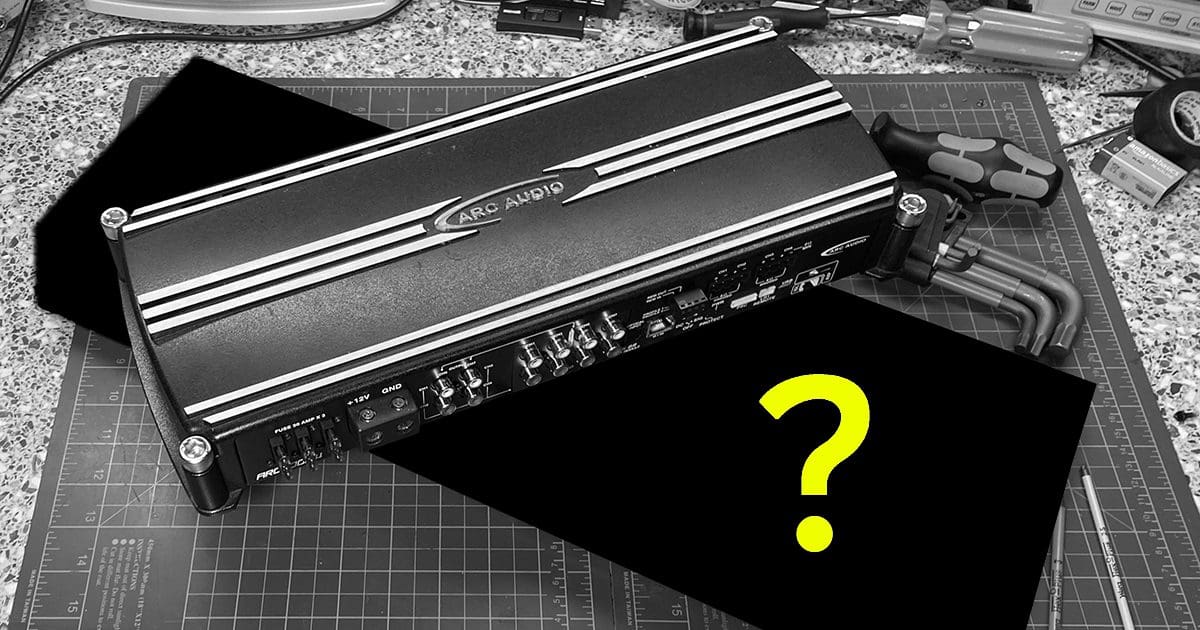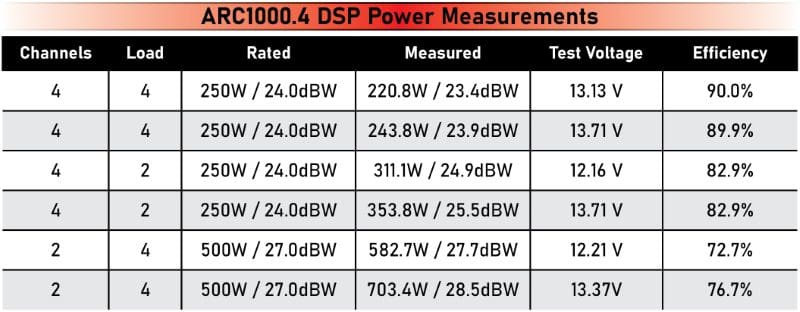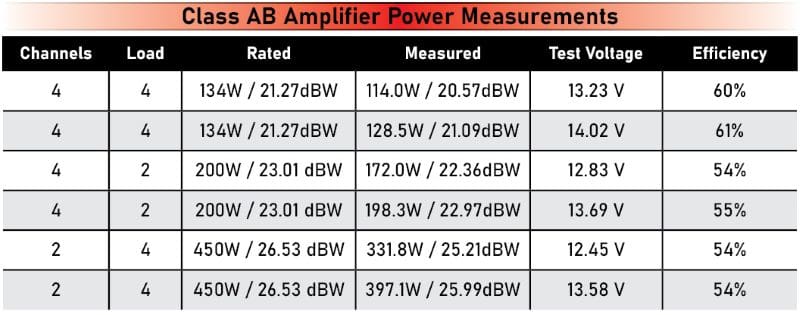I can’t count the number of times I’ve seen enthusiasts and folks in the car audio industry claim that Class AB amplifiers are better for high-frequency (as opposed to subwoofer) duties than a Class D design. I recently had a chance to put a popular new Class AB amp through its paces on the BestCarAudio.com Test Bench, and the results were surprising. Let’s make a quality comparison of this entry-level Class AB amp to a premium full-range Class D solution.
What Determines Amplifier Quality?
In the context of car audio amplifiers, quality is determined by how accurately an amplifier passes a signal to the speakers. More specifically, we want the amp to imprint as little change as possible and not add any unwanted information. Any distortion or noise added by the amp is a bad thing. That said, every amplifier from every company and at any price point adds a little something. The less it adds, the better it is.
For this article, I’ll use the ARC Audio ARC1000.4 DSP amplifier I reviewed a few years ago to compare to this entry-level Class AB amp. The ARC1000.4 is rated to produce 250 watts per channel into 2- or 4-ohm loads. Each pair of channels can be bridged to produce 500 watts into a 4-ohm load. This particular amp is equipped with the ARC Audio IPS8.8 digital signal processor. It has a full suite of crossovers, equalization, input mixing, signal delay and all-pass filtering goodness on board.
The competitor in this example is a physically large entry-level four-channel Class AB amplifier from one of the popular internet brands. These amps have been all the rage with amateur car audio YouTubers over the last few months. Of course, as a reader of BestCarAudio.com, you know power measurements have nothing to do with determining amplifier quality. An amp can sound horrible even if it makes a lot of power.
This behemoth is rated to produce about 135 watts of power into four 4-ohm loads and 200 watts per channel when running four 2-ohm speakers. Per the company’s’ website, each pair of channels can be bridged to deliver 450 watts of power into a 4-ohm load. This claim is troublesome, as bridged power ratings should be very close to the sum of the stereo 2-ohm ratings. If I were reading this information, I’d already question whether any of the data was accurate. Nevertheless, let’s see what happens there.
Round 1: Power Measurements
Every power measurement we make here at BestCarAudio.com is done under the guidelines of the ANSI/CTA-2006-C Testing and Measurement Methods for In-Vehicle Audio Amplifiers standard. This standard requires that the amp be powered with no more than 14.4 volts DC and that the output signal should contain no more than 1% total harmonic distortion and noise (THD+N).
Let’s break these measurements down piece by piece. The ARC amp was about 6 watts short of its 250-watt rating when driving 4-ohm speakers. Given that the supply voltage was 13.7 and not 14.4, I have no problem believing it would have made well over 250 watts per channel. Coincidently, the Class AB amp fell short of its 4-ohm rating by almost the same amount. We’ll call this a tie.
With the amplifiers driving 2-ohm loads, things changed a little bit. The Class AB was very close to its rated spec of 200 watts per channel with a measurement of 198.3 watts. On the other hand, the ARC Audio decided that its 250-watt-per-channel rating was irrelevant, and it cranked out a whopping 353.8 watts into four 2-ohm loads. For dramatically exceeding its power ratings, ARC Audio wins this test by a landslide.
The last power test was to run the amp as a two-channel with each pair of channels bridged to a 4-ohm load. The ARC1000.4 DSP has a rating of 500 watts yet mustered 703.4 watts with a supply voltage of a full volt under the 14.4 requirement. Son of a diddly! The Class AB amp didn’t do as well in this test. It was supposed to make 450 watts (which is theoretically impossible with a 200-watt-per-channel 2-ohm rating). It made 397.1 watts per pair of channels as the output signal hit 1% distortion. Supplied with the full 14.4 volts, it might have come closer to its rated power output capabilities. This is a hands-down win for the ARC Audio amp, besting its bridged ratings by 40% and giving consumers a lot more than they expected. As they say, underpromise and overdeliver!
ARC Audio Class D 3
Entry Class AB 1
Round Two: Total Harmonic Distortion and Noise
For us, amplifier sound quality is quantified by a design’s ability to amplify a signal without adding noise or distortion. We’ll run both amplifiers on our audio analyzer with a very pure 1-kHz test tone and the amp’s output at a level of 1 watt into a 4-ohm load, which correlates to an output of 2 volts RMS.
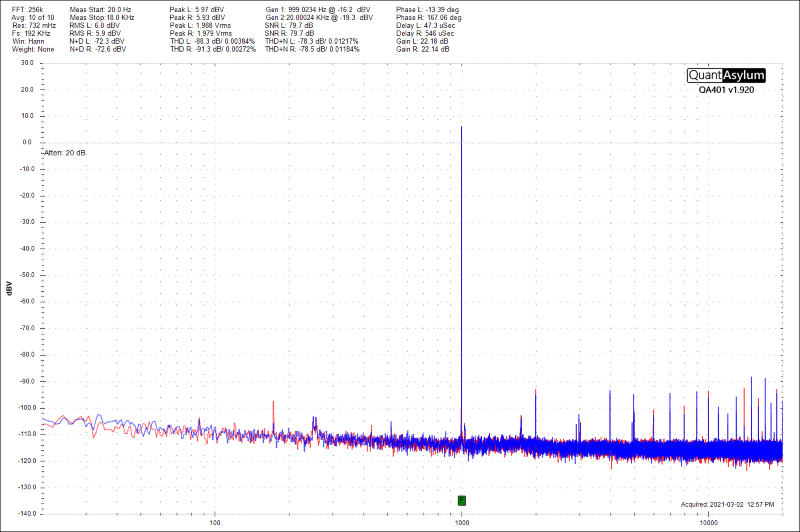
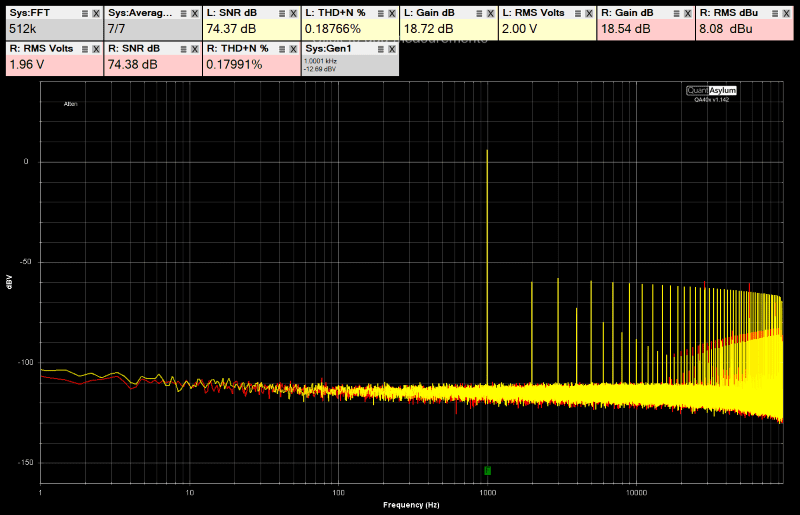
Allow me to explain what you’re seeing. The ARC Audio graph was measured a while back with my QA401 analyzer (which has been upgraded twice since then). The tall spike at 1 kHz is the test tone generated by the analyzer. The small spikes at 2, 4 and 5 kilohertz at levels below -92 dBV are harmonics of this test tone added by the amp. In quantifying these measurements, this equates to a total harmonic distortion (THD) specification of 0.00384% for the left channel and 0.00272% for the right. Uber-high-end Class AB amplifiers have difficulty matching numbers like these. When we include the background noise (similar for both amps), the THD+N specs are 0.01217% on the left and 0.01184% on the right channel as tested.
On the other hand, the Class AB amp has added even- and odd-spaced harmonics at a high level of about -60 dBV, reaching nearly 100 kHz. Think about how much unwanted information that is, especially for the tweeters. This would sound terrible. By way of numbers, we’re looking at 0.18766% on the left and 0.17991% on the right channel as tested. That’s more than 15 times as much distortion from an amplifier design that most people claim should sound better. Hands-down win to the ARC Audio amp here.
ARC Audio Class D 4
Entry Class AB 2
Round Three: Background Noise
Background noise is very similar for both amps. The Class AB amplifier’s noise floor slopes from -105 dBV at bass frequencies to between -110 to -120 dBV at the top end. The ARC 1000.4 DSP is nearly identical. We’ll call this a tie, even though the Class AB should be better, and the ARC amp is hindered by including a digital signal processor in the signal chain.
ARC Audio Class D 5
Entry Class AB 2
Round Four: Intermodulation Distortion
Another type of distortion worth testing is intermodulation distortion. When two tones are played simultaneously, an amplifier will add a tone that’s the difference between the two. For this test, I played 19- and 20-kHz tones. This is called the CCIF2 IMD test. Using the audio analyzer, we can measure how loud the difference signal is at 1 kHz (20 kHz minus 19 kHz).
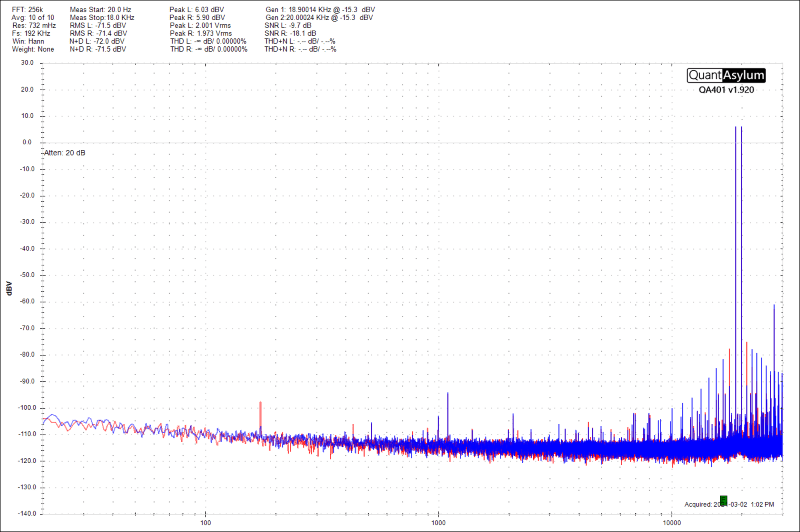
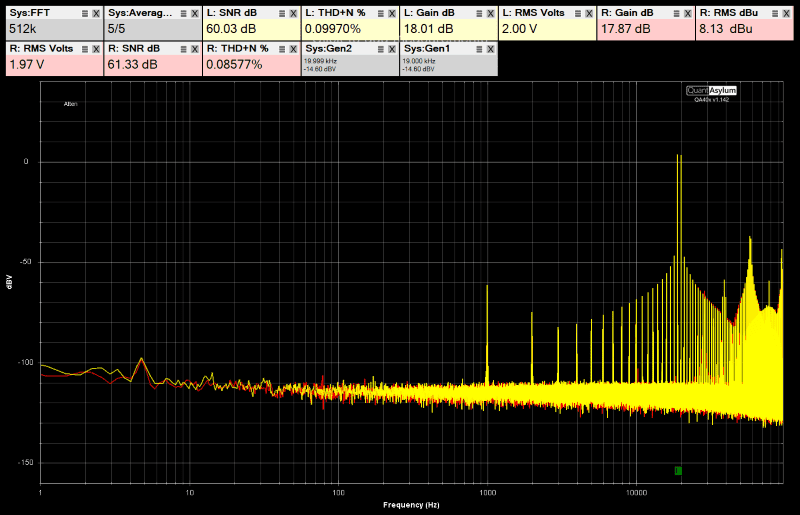
Sadly, this is another significant win for the ARC Audio amp. The difference produced at 1 kHz is at a level of about -94 dBV. That would be 0.001994% using a quantitative value relative to the test signal. The Class AB amp had a 1 kHz product at -61 dBV, which equates to 0.0891%. This time, the Class AB is more than 44 times as bad.
It’s also worth looking at the level of the sidebands around the 19- and 20-kHz stimulus signals. The Class AB has 18- and 21-kHz information that’s around -47 dBV – some of the worst I have measured. The ARC1000.4 DSP has the same unwanted information but at a level of -75 and -78 dBV. This is several orders of magnitude worse. This is another big win for the ARC Audio amp.
ARC Audio Class D 6
Entry Class AB 2
Round Five: Amplifier Efficiency
If you look at the power measurement chart, you can see how efficiently the amplifiers converted electrical system power into signals to drive the speakers. It should be no surprise that Class D will be better in this regard, but the difference is dramatic. Classically, car audio enthusiasts are willing to take a bit of a power consumption hit by using a Class AB amplifier in hopes that it would outperform a Class D in terms of sound quality. In this case, the tables have turned.
Let’s work backward through the math to see just how important this is.
The Class AB amp drew just over 105 amps of current to produce 793 watts of power. The ARC Audio amp made 80% more power to drive speakers while consuming only 19 more amps of current (about 18%). If you had a high-output audio system where you wanted the most power for your speakers, then choosing an amplifier that is as efficient as possible only makes sense. If you want your system to play at high volume levels, you want a very efficient Class D amplifier – another point for the ARC Audio ARC1000.4 DSP.
Score:
ARC Audio Class D 7
Entry Class AB 2
Experienced Design Engineering Delivers Better Quality Amplifiers
I can provide four or five more examples where the performance of these amplifiers varied dramatically. Crosstalk, distortion vs. frequency, the lack of differential inputs and much more make this cheap amp an unwise decision for anyone who cares about how their audio system sounds.
The ARC Audio ARC1000.4 D four-channel Class D amplifier obliterates this entry-level Class AB amp. The only time this Class AB came close to the ARC Audio amp was in situations where it should have beat it handsomely, based on the performance stereotypes of the two. Perhaps awarding points to both for a tie wasn’t the right choice. A score of 5 to 0 is a better representation of the difference between these solutions. Nevertheless, that’s how things played out, and I’m not one to hide data.
Many will argue that this entry-level (or what I’d call poorly designed) Class AB should have been given some slack because it’s 25% the price of the ARC amp. I never think that way. Quality is quality. Products that measure well always sound great. Products that measure poorly are always sonically disappointing. This is why I test products for the readers of BestCarAudio.com and for audio equipment manufacturers and distributors worldwide – to determine what’s good and what isn’t. In my opinion, if you think the Class AB is “good for the money,” you are wrong. It’s not good. It’s not even OK. It’s disappointing, and frankly, I’m embarrassed that anyone would offer this to the public.
Let’s look at this comparison another way. Say there’s a drag race between a Ford Mustang and a McLaren 720S. The first across the finish line is the winner. The timing system at the track doesn’t care what either competitor costs. In this example, the amp that should have sounded better, based on the infamous and now-debunked Class AB vs. Class D rivalry, has failed miserably. This is the second-worst amplifier I’ve ever formally tested. The worst was also a Class AB four-channel amp that retailed for less than $60 on Amazon. I’ve examined some nasty Brazilian-made Class D amps but haven’t done complete lab tests on them.
If you’re shopping for an amplifier for your car or truck, drop by a local specialty mobile enhancement retailer and audition some of the options they have on display in the store and their demo vehicles. Forget how loudly the system plays and focus on how real the music sounds. If you want to claim that your audio system sounds good, accuracy is all that matters.
